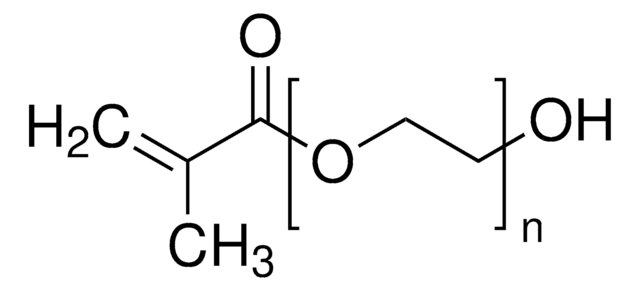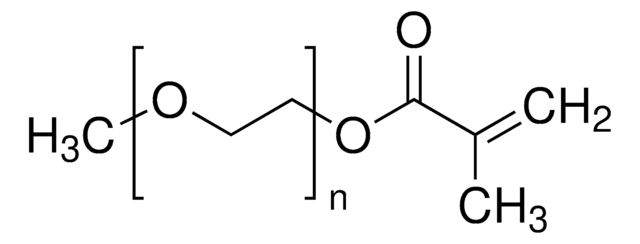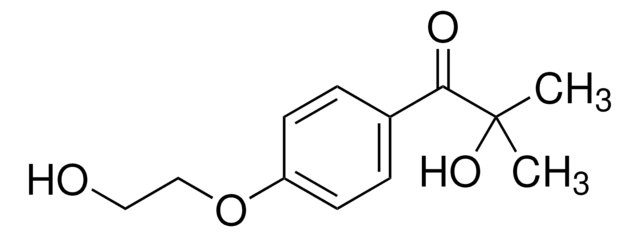推荐产品
产品名称
聚乙二醇二甲基丙烯酸酯, average Mn 550, contains 80-120 ppm MEHQ as inhibitor, 270-330 ppm BHT as inhibitor
形狀
liquid
分子量
average Mn 550
包含
270-330 ppm BHT as inhibitor
80-120 ppm MEHQ as inhibitor
反應適用性
reagent type: cross-linking reagent
reaction type: Polymerization Reactions
折射率
n20/D 1.466
bp
>200 °C/2 mmHg (lit.)
密度
1.099 g/mL at 25 °C
Ω-end
methacrylate
α-end
methacrylate
聚合物結構
shape: linear
functionality: homobifunctional
儲存溫度
2-8°C
SMILES 字串
OCCO.CC(=C)C(O)=O
InChI
1S/C10H14O4/c1-7(2)9(11)13-5-6-14-10(12)8(3)4/h1,3,5-6H2,2,4H3
InChI 密鑰
STVZJERGLQHEKB-UHFFFAOYSA-N
正在寻找类似产品? 访问 产品对比指南
應用
- 负载PDGF-AA的光交联壳聚糖水凝胶可促进伤口愈合。:本研究考察了与聚乙二醇二甲基丙烯酸酯(PEGDMA)光交联的壳聚糖水凝胶递送PDGF-AA并促进伤口愈合的作用。结果表明,伤口闭合率和组织再生情况显著改善(Cai et al., 2024)。
- 光接枝两性离子水凝胶涂层减少人工耳蜗及其材料在体内的异物反应。:本研究探讨了PEGDMA在两性离子水凝胶涂层中的应用,最大限度地减少人工耳蜗的异物反应。涂层显著减少了炎症,提高了体内的生物相容性(Horne et al., 2023)。
- 基于实验和响应面法的全因子设计可用于评估光固化PEDMA基支架单轴压缩机械性能和生物相容性的变化。:本研究采用全因子设计优化PEDMA基支架的机械性能和生物相容性,重点介绍了其在组织工程和再生医学中的潜在应用(Bharadwaz et al., 2023)。
- 光接枝两性离子水凝胶薄膜涂层的防污性能和机械性能取决于交联密度。:本文研究了PEDMA基水凝胶涂层交联密度的变化对其防污性能和机械性能的影响。这些发现对耐用且生物相容性医疗器械涂层的开发具有重要意义(Jensen et al., 2021)。
- 生物相容性和光交联性聚乙二醇/角蛋白生物复合水凝胶。:该研究介绍了PEGDMA/角蛋白生物复合水凝胶的发展,展示了优异的生物相容性以及在药物递送系统和组织工程中的应用前景(Wang et al., 2021)。
儲存類別代碼
10 - Combustible liquids
水污染物質分類(WGK)
WGK 1
閃點(°F)
Not applicable
閃點(°C)
Not applicable
其他客户在看
商品
In this article, we will discuss the benefits and limitations of several 2D and 3D scaffold patterning techniques that can be applied in the presence of cells. Although these methods will be discussed in the context of poly(ethylene glycol) (PEG)-based hydrogels, they can technically be applied to any optically transparent, photoactive substrate.
Progress in biotechnology fields such as tissue engineering and drug delivery is accompanied by an increasing demand for diverse functional biomaterials. One class of biomaterials that has been the subject of intense research interest is hydrogels, because they closely mimic the natural environment of cells, both chemically and physically and therefore can be used as support to grow cells. This article specifically discusses poly(ethylene glycol) (PEG) hydrogels, which are good for biological applications because they do not generally elicit an immune response. PEGs offer a readily available, easy to modify polymer for widespread use in hydrogel fabrication, including 2D and 3D scaffold for tissue culture. The degradable linkages also enable a variety of applications for release of therapeutic agents.
Devising biomaterial scaffolds that are capable of recapitulating critical aspects of the complex extracellular nature of living tissues in a threedimensional (3D) fashion is a challenging requirement in the field of tissue engineering and regenerative medicine.
我们的科学家团队拥有各种研究领域经验,包括生命科学、材料科学、化学合成、色谱、分析及许多其他领域.
联系技术服务部门







